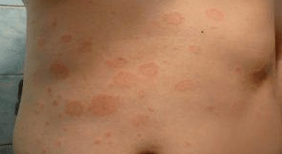What is Psoriasis and what does it look like?Psoriasis is the inadequate situation of the skin, as a result, red inflammatory boards, as well as dry scales, the result of extremely fast growth of skin cells.The disease affects the skin in the skin of the skin, knees and scalp.
Some people show herself in a light form, symptoms do not practically.Others record heavy symptoms, often relapse.Psoriasis will try to respond to where they come from, why they appear, the reasons for the appearance, how they are infected, these and other questions in the pages of our portal.

Psoriasis is an incurable, long (chronic) condition of the skin.The screenplay stages are replaced by phases of improvement.Many patients, in November, as well as the complication of symptoms in the hot summer in warm summer.Psoriasis affects representatives and representatives of both sexes.Psoriasis may seem to be seen in people of all ages - from babies to the elderly - the most diseases are diagnosed in adolescence in 20 years.
What age does psoriasis appear?Disease in babies (less than 4% of patients), children can show themselves when psoriasis are the ceremonies of the disease.In such young children, the psoriasis often gets sharp phason, tonsillitis, bronchitis or respiratory infections, cold, flu or pneumonia.People from Psoriasis are more likely than diabetes, hyperlipidemia, as well as heart diseases.
Why does psoriasis take place?The causes of psoriasis are not known until the end, but usually the disease is associated with the problem of immune system.What and how does Psoriasis look like?The main element is a specially type of lymphocyte called T-Lymphosites or T-cells.As a rule, these white blood cells move along the body to detect and remove and remove external items such as viruses or parasites.However, T-Lymphocytes with psoriasis patients were mistakenly healthy skin cells (to fight false infection).
Hyperactive lymphosis, including papules and pustriasis pustules, are provoking immune reactions, including expansion and increase in ships around pustules.These changes lead to the increase in both healthy skin cells and other white blood cells.This is a period of a period in a very fast time - a period of a period of new skin cells to the upper layers of the epidermis - a few days.
Tədqiqatçılar, həmçinin sedefin inkişafı ilə əlaqəli genlərin inkişafı ilə əlaqəli genləri tapdılar, xəstəliyin miras qaldığını, lakin ətraf mühitin xarici amilləri (dəridə fiziki, kimyəvi, istilik, balanssız qidalanma, spirt və siqaretdən artıq / müntəzəm / müntəzəmdən istifadə etməklə) da müəyyən rol oynayır.
Signs and symptoms
Psoriasis shows itself in the form of red or pink scaled cones, which combines large papules (board) of the skin.Sometimes, these small dry white scales are browsing, light bleeding.
There are several types of psoriasis - the pistila (affects large areas of skin) and is a pustule (a more rare form, usually in hand or legs).There may be different contours and shapes in the rash - from the point and to a rocky money.
The first signs of psoriasis are growing fatigue, weakness throughout the body, sometimes a little dizziness, a common disease.Machines are developing and increasing, itching, burning, pain, sometimes symptoms such as fever, chickens.
Stage
In the absence of treatment, psoriasis is developing quite rapidly.At the initial stage, small pink or red scales appear on the skin (usually located symmetrically, such as the spots in both hands will be located in the same way).Later, on the red spots, a scaling surface layer begins to develop.

It is easily independently removed, it is a kerated skin.After the scales form, red spots are collected on large red boards, this stage is accompanied by severe itching and burning, as well as skin peeling.
Aggravation
The heavy development of the skin (board, grandfather), Severe itching, burning, often pain, burning, often pain.The area of the disease also increases significantly (boards are more than 10 cm in diameter).Feels a special skin density.You must contact a specialist immediately while taking the disease into the sharpening stage.During this stage, lamps appear on the skin (due to density, dryness and keratinism).
Danger to life
At the stage of aggravation, the cerated dry areas crack, the skin begins to bleed and infects infections is more sensitive, which leads to new boards (Köbner syndrome).
The most serious outcome of the screen can be psorized arthritis.
Psoriasis continues to be one of the most complex skin diseases.Wide procedures for the treatment of psoriasis show this.It is very important to take measures to prevent the disease and prevent the stage of aggravation, for this requires a specialist to ask for help, as well as to change your lifestyle, and the methods and methods of operation.























